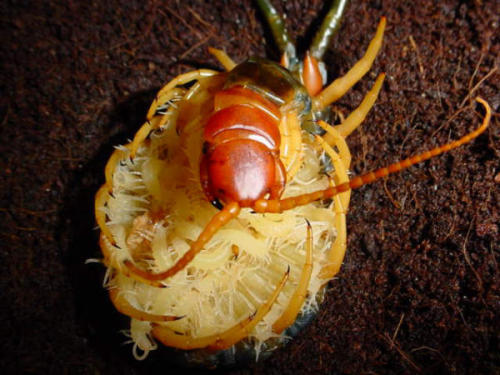AD&D Cockatrice
Cockatrice turn people to stone via touch, and come in small groups of 1d6. One thing you probably wouldn't expect from a chicken sized monster is that it has 5hd and a low AC, making it a sort of HP sponge that will give it plenty of opportunities to force saves vs stone. Like the Basilisk, its petrification aura 'extends into both the astral and ethereal planes' making it a menace to things like ghosts and, I suppose, githyanki space pirates. One must assume that touch-based petrification is not prevented by armor or clothing, explaining the high hit chance of a 5hd creature.
3.5 Cockatrice
Pretty much the same, but instead of multidimensional petrification, they have immunity to other cockatrice petrifications, presumably so they can breed.
Mythic Cockatrice
Displaying overlap with Basilisks, some cockatrice had killing gazes to be reflected by mirrors. Or dealt with with weasels, who were immune. Some had killing breath, or a vulnerability to a rooster crowing. As with many D&Disms, petrification is a softening of the death-bringers of mythology.
They are also said to be descended from an egg laid by a rooster and incubated by a toad or snake (vice versa results in a Colo Colo).
Nethack Cockatrice
These turn you to stone with a touch even after death, making them dangerous hazards. They also can turn you to stone if you hear them hiss, though this can be prevented by eating a lizard.
Sunset Realm Cockatrice
Yg, Mother of Serpents, Longest Librarian, etc etc, is responsible for many petrification effects, or at least the ones that rely on a memetic infohazard to induce a liminal stasis loop between comprehension and ignorance (further explanation requires continuation in the Serpentine language, not clumsy Commonid).
 |
| thousands of years of magical weaponsmithing will probably never compare to a cursed chicken on a stick |
As the contact petrification occurs due to fractal feathers encoded with infohazards communicating via the feeling of the fractal feathers, thick gloves, armor, or even nerve damage are sufficient protection against the touch of a cockatrice, but fresh, undamaged cockatrice corpses retain their power. Individual feathers are not sufficient, and rearranging the feathers unduly likewise alters the infohazard to uselessness, so the only option for wielding cockatrice as melee weapons really is to use the whole thing.
Cockatrice are ornery but not physically dangerous- they are snakey chickens is all. While fairly agile, one good hit should slay them, and apart from a minor possibility of losing an eye to a peck, petrification will ensue before anyone succumbs to chicken beak and talon. Weasels are immune to petrifaction due to rival Alvish bioengineering and will slay Cockatrice where they are found, and the crow of a rooster at dawn kills cockatrice instantly.
The Hiss- If you hear it clearly (within 30 feet or so) save vs stoning or pick a limb to turn to stone. An additional limb turns to stone every round/~10seconds. Snakes and weasels immune.
The Touch- Feeling a cockatrice's feathers on bare flesh (or through thin clothing, perhaps) causes a save vs instantaneous petrification, as does a successful melee attack from the beast.
Unlike basilisks, which require their own saliva to depetrify their victim, any snake, reptile, or frog venom will suffice to undo the touch of a cockatrice, as any old snake foot(or lack thereof) soldier needed to be able to destone prisoners.
The Toad Thing
The upstart Toads were able to come up with cockatrice of their own(as well as many other monstrosities), being well versed in the powers of change and metamorphosis. This didn't save them from the Snake Empire, but it explains why the froggy folk of the Dismal Bog (the moonland area of the Bog of the Canal) are so keenly aware of the dangers of cockatrice, for ancient lineages of the beasts (some said to have grown to tremendous sizes) are known to lurk in forgotten temples.
 | |||
| soggy, concealing cloaks and bandages to keep their skin moist are the outfit of the frog-ilk who venture into drier lands | , |



